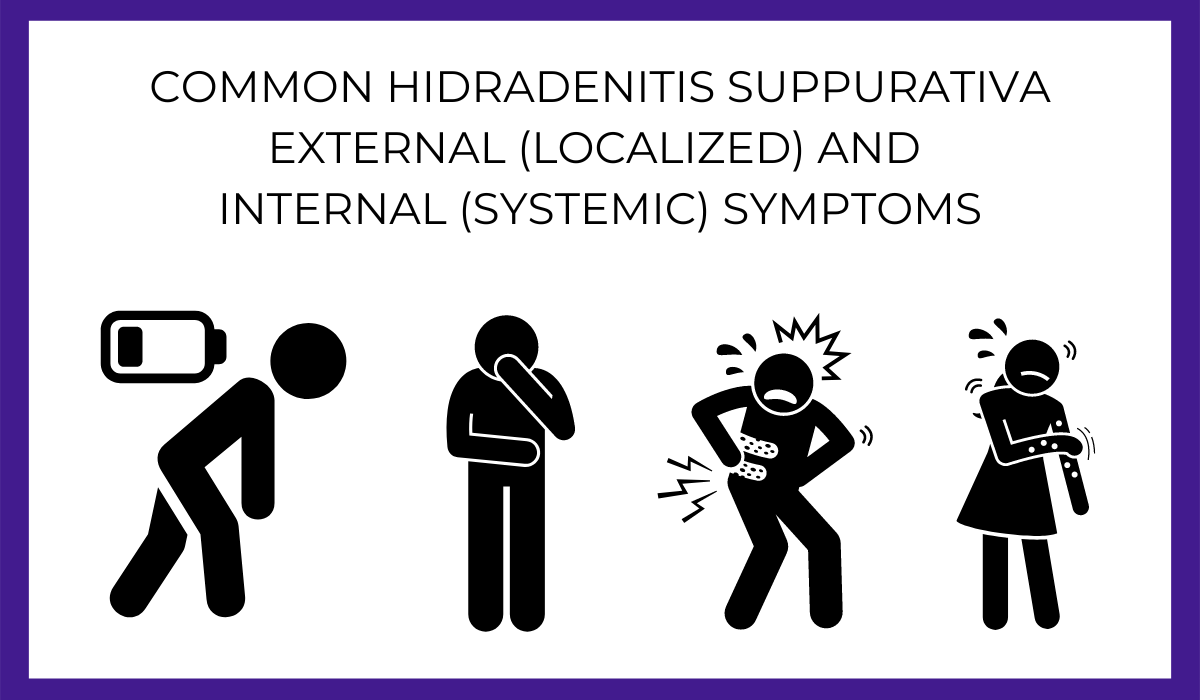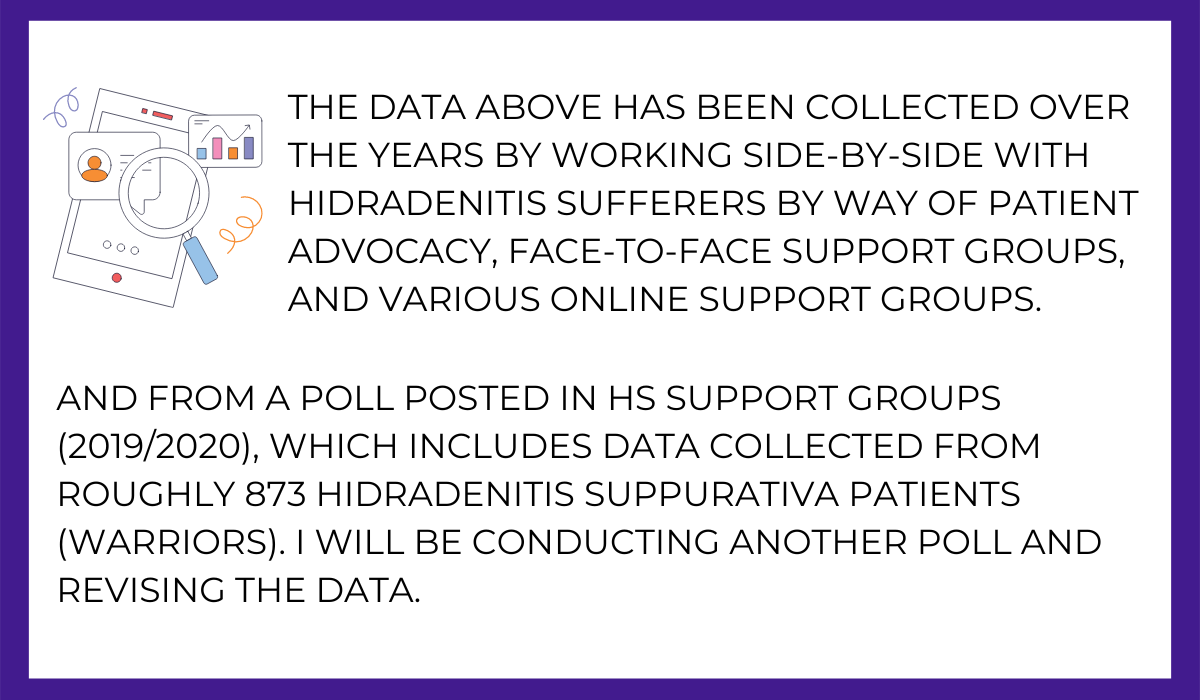Common Hidradenitis Suppurativa external (localized) and internal (systemic) symptoms

Hidradenitis Suppurativa is a non-contagious inflammatory illness that causes painful abscesses (boil-like), nodules underneath the skin, skin tunneling, and scarring (often extensive).
The following are the frequently reported external (localized) before, during, and after HS flares listed in order of the highest reported percentage.
- Pain Itching (pruritus)
- Pressure pain (hyperesthesia)
- Flushing (reddening)
- Throbbing pain (rhythmic waves or bursts)
- Stinging (pinching or electrical shock like)Burning sensation (tingling, warm, or burning pain)
- Nerve pain (burning, stabbing, or shooting sensations)
- Bruising Skin crawling (feeling of something crawling on the skin)
- Rashes
- Numbness
- Skin Peeling Referred pain (pain that is felt in a different location than the source of the pain)Tightness feeling of the skin
While pain and pressure are commonly felt by those with HS, the external symptoms can vary greatly, underscoring the unique nature of HS for each individual. The symptoms can differ significantly for each abscess/lump and location.
Let’s now explore the most frequently reported internal (systemic) symptoms experienced during flares.
The following are the frequently reported internal (systemic) symptoms before, during, and after HS flares listed in order of the highest reported percentage.
- Fatigue: This fatigue is different from the usual “lack of sleep” tiredness. This kind of fatigue involves constant tiredness and may manifest as physical exhaustion as well. This form of fatigue, also referred to as chronic fatigue, can be debilitating and may manifest with or without activity.
- Malaise: Feeling uneasy and unwell, with symptoms of aches and low energy.
- Nausea: The feeling that you may vomit; a queasy feeling that ranges from slightly uncomfortable to agonizing, often accompanied by clammy skin.
- Flush warm feeling without fever: It feels like you have a fever, but you don’t. You may experience a flushed face. You might even experience a warm sensation on your face or body. If this happens, always check your temperature to rule out a fever.
- Low-grade or Mild fever: The temperature is higher than usual, but below 100.4 F (ranging from 99 F to 100.4 F). If your temperature reaches 100.5 or above, especially in combination with other symptoms, it could be a sign of a more serious issue and it’s important to seek medical help.
- Cold Sweats: Experiencing chills and abnormal sweating, regardless of the temperature around you. It is possible to have cold sweats without a fever.
- Headaches: Has many different presentations
- Leg Weakness: Various factors can cause leg weakness. If it continues or becomes bothersome, please see a doctor.
- Low Temperature: This could occur due to a variety of factors, particularly if anemia is involved. In some cases, there can also be infection associated with this. Seek immediate medical attention if your body temperature falls to 95 F or lower.
- Dizziness: Dizziness can be caused by various factors such as pain, sudden movements, or dehydration. Should this become chronic, it is advisable to consult with your physician.
- Achy Joints: Chronic inflammation is among the potential causes for this. If this becomes chronic, bothersome, or debilitating, it’s important to talk to your doctor.
Even though the symptoms mentioned above are often seen in people with HS, please don’t automatically assume every symptom is connected to Hidradenitis Suppurativa. If you find anything unusual or out of the ordinary, consult your physician to rule out other causes before assuming it’s connected to your HS. If you observe any changes in your usual symptoms of HS flares, whether external or internal, make sure to consult your medical team or dermatologist.

In addition, research studies have shown that patients have symptoms before HS flares occur.
External (localized) symptoms included:
- Skin erythema (skin redness)
- Paraesthesia (pins and needles)
- Itching
Internal (systemic) symptoms included:
- Fatigue
- Malaise
- Headache
- Nausea
The majority of the patients stated that the prodromes (before symptoms) usually occurred > 24 h (45%) or 12-24 hours before the eruption. Patients with HS had a significantly higher fatigue score compared with the general population (especially more severe cases).
In 2025, a new study poll will be conducted by me. This resource article will be updated reflecting the new data.
Special Note: Researched, compiled, and written by Denise Fixsen. This information is backed by my 46 years of living with Hidradenitis Suppurativa, 10 years of dealing with multiple chronic illnesses, 36 years of advocacy, and continuous education. And to ensure accuracy, reliability, and trustworthiness, I incorporate peer-reviewed studies and other high-quality sources into my articles and material. I also wanted to inform you that I’ve chosen to end my collaboration with editors on my articles. Although there may be grammar errors due to brain illnesses (mostly), with this said, my content remains reliable, factual, and solid. With genuine TLC.
Medical Disclaimer: This content is solely for information, education, and support. The purpose is not to serve as a replacement for professional medical advice, diagnosis, or treatments.
Sources: PMCID: PMC7765202,doi: 10.1016/j.jid.2017.04.024, doi.org/10.1002/jvc2.345, doi: 10.1111/ced.13025, PMC10613171
This current resource article, now called “Common Hidradenitis Suppurativa external (localized) and internal (systemic) symptoms”, has been updated (to rev 3), posted on fixsensadnessforhs.com (09-07-2024). Rev 3 contains original materials/content from 2012, 2018, 2019, 2020, and additional current updated materials.
IMPORTANT: the HS non for-profit organization (hsconnect) often steals my ideas and work and that includes THIS article. HENCE this disclaimer; another version of my work and collected information and materials exists on their (hsconnect) website, and they use it on their social media platform (s) unauthorized and uncredited. I do NOT approve of the use of this material. It is only acceptable if it comes directly from me, fixsensadnessforhs.com, or via my social media platforms.
Article posted on 09-07-2024
